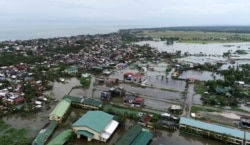Cyclone Amphan threatens massive devastation Wednesday when it is to make landfall along the India-Bangladesh border as the region continues to battle the coronavirus.
Formed over the Bay of Bengal, the super cyclone is equivalent to a Category 5 hurricane with wind speeds as high as 257 kph (160 mph) and gusts near 321 kph (200 mph).
The storm is expected to weaken to a Category 1 or 2 before reaching land, but Cyclone Amphan still has potential to cause severe damage to the densely populated and poverty-stricken regions with unstable infrastructure.
The Bay of Bengal shores are prone to natural disasters similar to Cyclone Amphan, yet none of these bordering countries have had to combat a combination of a global pandemic and an incoming violent storm.
Odisha, one of the Indian states in Amphan’s path, has begun preparations to evacuate the 1.1 million individuals who live in high-risk areas. According to The Guardian, 550 cyclone shelters have been readied, along with 7,000 concrete buildings set aside to shelter evacuees.
The Cox’s Bazar district of Bangladesh also is anticipating heavy rains from Amphan. Cox’s Bazar is home to the world’s largest refugee camp, where Rohingya refugees escaped violence in Myanmar’s Rakhine state.
The Rohingya refugee camp, with a population of nearly 1 million, recently confirmed its first coronavirus case making the refugees even more vulnerable to the threatening storm.
With the diagnosis, the camp immediately isolated two refugees, deployed investigative teams, and increased prevention and testing methods. However, health experts have been cautioning camps about the possibility of a rapidly spreading virus for more than two years.
“Our houses are already in bad shape and if heavy storm hit, we will be in despair with heavy rain and landslides," Aung Myaing, a grocery and general store owner in Kutuplong Camp in Cox's Bazaar, told VOA’s Burmese Service.
Last Thursday, the Philippines faced similar threats as Typhoon Vongfong made landfall and forced thousands to evacuate despite the coronavirus-induced lockdown.
Typhoon Vongfong consisted of 185 kph (115 mph) winds, making it as forceful as a Category 3 hurricane.
The coronavirus, keeping more than 50 million individuals on lockdown, complicated the evacuation process. According to Reuters, the central Philippines only permitted evacuation centers to reach half capacity and instructed all in those facilities to wear face masks.
Typhoon Vongfong was the first typhoon of the season, but the tropical Pacific region averages nine storms a year.
While the Philippines was able to prepare for the typhoon, taking COVID-19 measures into account, countries in Cyclone Amphan’s path have yet to release evacuation plans that are in line with lockdown and social-distancing guidelines.
“They [Bangladesh authorities and the International Organization for Migrations] gave us iron rods and strings to stabilize our tents and houses. However, they didn't give us plastic sheets and bamboo poles. I just wonder how to make shelters without plastic sheets as our tents are barely able to stay up in heavy winds and rain,” Aye Lwin, a refugee and former schoolteacher, told VOA,
VOA Burmese Service reporter Sumon Aye contributed to this report.










